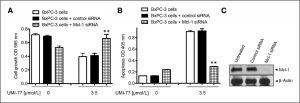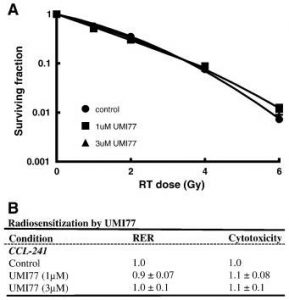
| Size | Price | Stock | Qty |
|---|---|---|---|
| 2mg |
|
||
| 5mg |
|
||
| 10mg |
|
||
| 25mg |
|
||
| 50mg |
|
||
| 100mg |
|
||
| 250mg |
|
||
| 500mg |
|
||
| Other Sizes |
|
Purity: ≥98%
UMI-77 (UMI 77; UMI77) is a novel, potent and selective Mcl-1 (Myeloid cell leukemia-1) inhibitor with Ki of 490 nM. Myeloid cell leukemia-1 (Mcl-1) is a powerful anti-apoptotic protein and a member of the prosurvival Bcl-2 family. In a variety of human cancers, Mcl-1 plays a crucial role in survival. In FP-based binding assays, UMI-77, a small-molecule Mcl-1 inhibitor, potently and specifically displaces fluorescently labeled BID-BH3 peptide from Mcl-1 protein with a Ki value of 0.49 M and binds to the BH3 binding pocket of Mcl-1 protein. UMI-77 had Ki values of 5.33, 8.19, 23.83, and 32.99 μM for its binding to A1/Bfl-1, Bcl-w, Bcl-2, and Bcl-xL, respectively. UMI-77 at 10 M successfully and dose-dependently inhibited the interactions between BL-Noxa and cellular Mcl-1 in a pull-down assay.
| Targets |
Mcl-1 (Ki = 0.49 μM); Bfl-1 (Ki = 5.33 μM); Bcl-W (Ki = 8.19 μM); Bcl-2 (Ki = 23.83 μM); Bcl-xL (Ki = 32.99 μM)
|
|||
|---|---|---|---|---|
| ln Vitro |
UMI-77 effectively disrupts the interactions between BL-Noxa and cellular Mcl-1, as well as Mcl-1/Bax protein–protein interactions.[1] UMI-77 inhibits the growth of BxPC-3, Panc-1, MiaPaCa-2, AsPC-1, and Capan-2 cells, with IC50 values of 3.4, 4.4, 12.5, 16.1, and 5.5 M, respectively. Through the activation of the intrinsic apoptotic pathway and/or a change in Bax conformation, UMI-77 caused pancreatic cancer to undergo apoptosis. [1]
|
|||
| ln Vivo |
UMI-77 (60 mg/kg i.v.) exhibits single-agent antitumor activity without causing any harm to healthy tissues in a BxPC-3 xenograft mouse model. [1]
|
|||
| Enzyme Assay |
The concentrations of the proteins used in the competitive binding experiments are 90 nM for Mcl-1, 40 nM for Bcl-w, 50 nM for Bcl-xL, 60 nM for Bcl-2, and 4 nM for A1/Bfl-1 based on the Kd values. A1/Bfl-1 uses FAMBID at 1 nM instead of the fluorescent probes Flu-BID and FAM-BID, which are both fixed at 2 nM for all other assays. 5 μL of the tested compound in DMSO and 120 μL of protein/probe complex in the assay buffer (100 mM potassium phosphate, pH 7.5; 100 μg/ml bovine gamma globulin; 0.02% sodium azide) are added to assay plates (Microfluor 2Black), incubated at room temperature for 3 h and the polarization values (mP) are measured at an excitation wavelength at 485 nm and an emission wavelength at 530 nm using the plate reader Synergy H1Hybrid. Nonlinear regression fitting of the competition curves is used to calculate IC50 values.
|
|||
| Cell Assay |
The human pancreatic cancer cell lines AsPC-1, BxPC-3, and Capan-2 are cultured in RPMI-1640 medium, whereas Panc-1 and MiaPaCa are cultured in Dulbeccos' Modified Eagle's Medium (DMEM), both of which are supplemented with 10% FBS. The WST-8 assay is used to determine the degree of cell growth inhibition following treatment with compounds at increasing concentrations.
|
|||
| Animal Protocol |
|
|||
| References |
| Molecular Formula |
C18H14BRNO5S2
|
|---|---|
| Molecular Weight |
468.34
|
| Exact Mass |
466.949
|
| Elemental Analysis |
C, 46.16; H, 3.01; Br, 17.06; N, 2.99; O, 17.08; S, 13.69
|
| CAS # |
518303-20-3
|
| Related CAS # |
UMI-77-d4
|
| PubChem CID |
992586
|
| Appearance |
White to off-white solid powder
|
| Density |
1.79±0.1 g/cm3
|
| Boiling Point |
661.2±65.0 °C at 760 mmHg
|
| Flash Point |
353.7±34.3 °C
|
| Vapour Pressure |
0.0±2.1 mmHg at 25°C
|
| Index of Refraction |
1.781
|
| LogP |
3.57
|
| Hydrogen Bond Donor Count |
3
|
| Hydrogen Bond Acceptor Count |
7
|
| Rotatable Bond Count |
6
|
| Heavy Atom Count |
27
|
| Complexity |
618
|
| Defined Atom Stereocenter Count |
0
|
| SMILES |
O=C(O)CSC1=CC(NS(=O)(C2=CC=C(Br)C=C2)=O)=C3C=CC=CC3=C1O
|
| InChi Key |
WUGANDSUVKXMEC-UHFFFAOYSA-N
|
| InChi Code |
InChI=1S/C18H14BrNO5S2/c19-11-5-7-12(8-6-11)27(24,25)20-15-9-16(26-10-17(21)22)18(23)14-4-2-1-3-13(14)15/h1-9,20,23H,10H2,(H,21,22)
|
| Chemical Name |
2-[4-[(4-bromophenyl)sulfonylamino]-1-hydroxynaphthalen-2-yl]sulfanylacetic acid
|
| Synonyms |
UMI77; UMI 77; UMI-77
|
| HS Tariff Code |
2934.99.9001
|
| Storage |
Powder -20°C 3 years 4°C 2 years In solvent -80°C 6 months -20°C 1 month |
| Shipping Condition |
Room temperature (This product is stable at ambient temperature for a few days during ordinary shipping and time spent in Customs)
|
| Solubility (In Vitro) |
|
|||
|---|---|---|---|---|
| Solubility (In Vivo) |
Solubility in Formulation 1: ≥ 2.5 mg/mL (5.34 mM) (saturation unknown) in 10% DMSO + 40% PEG300 + 5% Tween80 + 45% Saline (add these co-solvents sequentially from left to right, and one by one), clear solution.
For example, if 1 mL of working solution is to be prepared, you can add 100 μL of 25.0 mg/mL clear DMSO stock solution to 400 μL PEG300 and mix evenly; then add 50 μL Tween-80 to the above solution and mix evenly; then add 450 μL normal saline to adjust the volume to 1 mL. Preparation of saline: Dissolve 0.9 g of sodium chloride in 100 mL ddH₂ O to obtain a clear solution. Solubility in Formulation 2: 2.5 mg/mL (5.34 mM) in 10% DMSO + 90% (20% SBE-β-CD in Saline) (add these co-solvents sequentially from left to right, and one by one), suspension solution; with ultrasonication. For example, if 1 mL of working solution is to be prepared, you can add 100 μL of 25.0 mg/mL clear DMSO stock solution to 900 μL of 20% SBE-β-CD physiological saline solution and mix evenly. Preparation of 20% SBE-β-CD in Saline (4°C,1 week): Dissolve 2 g SBE-β-CD in 10 mL saline to obtain a clear solution. View More
Solubility in Formulation 3: 5% DMSO+30% PEG 300+dd H2O: 6 mg/mL |
| Preparing Stock Solutions | 1 mg | 5 mg | 10 mg | |
| 1 mM | 2.1352 mL | 10.6760 mL | 21.3520 mL | |
| 5 mM | 0.4270 mL | 2.1352 mL | 4.2704 mL | |
| 10 mM | 0.2135 mL | 1.0676 mL | 2.1352 mL |
*Note: Please select an appropriate solvent for the preparation of stock solution based on your experiment needs. For most products, DMSO can be used for preparing stock solutions (e.g. 5 mM, 10 mM, or 20 mM concentration); some products with high aqueous solubility may be dissolved in water directly. Solubility information is available at the above Solubility Data section. Once the stock solution is prepared, aliquot it to routine usage volumes and store at -20°C or -80°C. Avoid repeated freeze and thaw cycles.
Calculation results
Working concentration: mg/mL;
Method for preparing DMSO stock solution: mg drug pre-dissolved in μL DMSO (stock solution concentration mg/mL). Please contact us first if the concentration exceeds the DMSO solubility of the batch of drug.
Method for preparing in vivo formulation::Take μL DMSO stock solution, next add μL PEG300, mix and clarify, next addμL Tween 80, mix and clarify, next add μL ddH2O,mix and clarify.
(1) Please be sure that the solution is clear before the addition of next solvent. Dissolution methods like vortex, ultrasound or warming and heat may be used to aid dissolving.
(2) Be sure to add the solvent(s) in order.
|
|---|
 |
 |